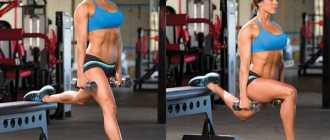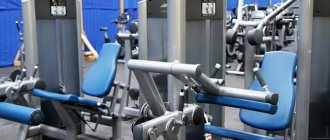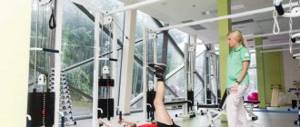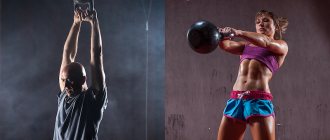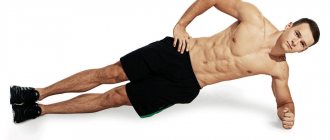Power machine - Smith machine. Hidden benefits.
Who do you think invented this simulator, a man named Smith? Yes, this is the first and most obvious thing that comes to mind, but everything is not so simple. It is believed that the idea of creating the Smith machine belongs to the famous bodybuilder of the 20th century, Jack LaLanne. It was his bright head that struck the idea of the design of a power machine. But without attaching much importance to documentation, paperwork and patents, his brainchild smoothly flowed to a more “nimble” and efficient engineer named Smith, who developed a complete package of technical documents for this simulator.
- Note: LaLanne is known for his strength records. In 1965, he did 1,033 push-ups in 23 minutes, and at the age of 45, he completed 1,000 jumping jacks and 1,000 pull-ups in just 1 hour and 22 minutes. Impressive, isn't it?
Thus, Smith immortalized his name for centuries, along with Edison (light bulb) and the Wright brothers (airplane).
This is such an unusual story. Now let's figure out why the Smith simulator is unusual and universal? Ask anyone in your gym what isolation machines are for and they will immediately answer - to polish the muscles. Yes, this is true, but the strength machine is rather an exception to the rule, a “wrong sandwich” whose goal is to build muscle mass. Thanks to its design, it allows you to perform a variety of simple and complex (including multi-joint) exercises, while providing total control over the technique of their implementation. This is an excellent tool for hypertrophy of muscle fibers, allowing you to work with high intensity and at a good pace.
If the exercise machine is so useful, then why do so many people dislike it?
Reason ❶ - Predetermined, fixed trajectory of movement (fixed plane) It is believed that training in a fixed plane is unnatural for a person, because. the body uses fewer joints to perform the movement. For example, when squats, only the knees are involved, while the hip and ankle joints are excluded from the work. Yes, fewer joints are involved in the movement, but if you need to focus on working out one target muscle group (quadriceps), then the Smith machine (with legs placed in front) is the best single-joint solution.
In addition, in case of back injuries, the power machine allows you to keep your back strictly vertical, which allows you to painlessly perform squats in it, unlike working with free weights.
Reason ❷ - The simulator is not universal and not functional. This means that it has very few applications in everyday training activities. This is not at all true, because it has a lot of applications and you can perform the lion’s share of exercises in it, the main thing is to know which ones and how correctly.
Reason ❸ - The core stabilizer muscles do not develop. By and large, not everyone wants these muscles to develop. Some people just need big quadriceps and maximum hypertrophy; they don’t care about these stabilizers.
- Note: Of course, the stabilizer muscles are an important muscle layer that needs to be trained from time to time (with the same squats, pull-ups, etc.), however, it is foolish to avoid the Smith machine for this reason alone.
It is also worth saying that for many athletes, when stabilizers are injured, ordinary bench presses turn into “excruciating torture,” but a power machine will allow you to do all this in no time.
Reason ❹ - Friends at the gym say that Smith sucks Yes, perhaps this is true, but only in the eyes of your friends who know little about how to do this machine. You don’t have to listen to anyone and take their word for it, try it yourself and decide for yourself.
Now let's figure out what advantages the Smith machine has.
Firstly, it prevents boredom. Agree, it is a rather uninteresting activity to perform the same exercise (or a set of exercises) from training to training for a long time. A person is not a machine and he needs to add variety to his program from time to time, otherwise training will stop bringing pleasure, you will get bored and eventually give up on the whole thing. In addition, muscles have a very high adaptability, so over time it will be very difficult to “surprise” them even with increased loads. The best option for changing the angle of attack of the muscles may be to perform exercises in a Smith machine.
The second advantage can undoubtedly be called safety. Due to the immobility of the structure and the given trajectory of the projectile along the guides, the machine has minimal negative impact on the joints (compared to exercises with free weights).
And the third advantage (by no means least important) is good muscle hypertrophy, which is achieved through targeted and constant impact of the weight of the projectile into the trained working area. Tension in the muscle is maintained throughout the entire trajectory of movement, constantly - this is achieved due to the specific design of the simulator.
Before moving on to practice - the list of exercises in the Smith machine, I’ll say a few words about who this machine is for?
As I see it, this simulator is both for athletes with an average level of fitness (from 2 years of training in the gym or more) and for beginners. It is even better suited for beginners, because at the initial stage of the training process, it is coordination, basic exercises with free weight that are very difficult. There are too many factors converging here. Beginners need to monitor the position of the body in space (balance), and the working weight, and the stages of movement of the projectile. All this is not an easy task, because... you need to concentrate on so many factors at once.
The optimal solution in this case is the Smith simulator; it is this that allows you to remove all the headaches and focus on the execution technique. In addition, for athletes who cannot feel how a muscle works (due to still underdeveloped neuromuscular connections), the strength machine gives this sensation, it has been verified.
- Note: From personal experience, I can say that when performing an exercise such as the bench press on a horizontal bench with free weight, I practically did not feel the work of the pecs at all. Everything changed when I switched to the Smith machine version of this exercise.
Smith machine squats: technique
Before starting squats in the Smith machine, the athlete must take the starting position. It may differ depending on the goals set for the training process.
Initial position
To take the starting position, you need to fix the barbell by turning the bar at the desired height.
It is selected in such a way that in order to lift the barbell the athlete is forced to sit slightly under it.
Having set the height and set the desired weight, the athlete must go under the bar and place his feet in the desired position.
By the way, if you don’t yet know how to choose a working weight, then I explained it in this article.
- The basic position involves having your feet shoulder-width apart or slightly wider, your feet under the bar or slightly pointed out, and your toes pointing forward or slightly outward. This position allows you to create an even load on all muscle groups, but requires a certain flexibility if the bodybuilder has a body that is elongated relative to the legs. It is in this case that moving your feet forward a little helps. It is this position that I will show you a little lower in the diagram.
- The sumo position (where your legs are spread very wide and your feet are apart by about 60 degrees or more) is designed to focus on the inner head of the quadriceps and buttocks. In order to take the desired position, you should place your legs wider than your shoulders, at a distance that allows the athlete to squat until the thighs are “parallel” with the floor or even lower. The toes are turned very outward, which emphasizes the force on the inner quadriceps.
- If you place your feet shoulder-width apart or even narrower, moving them forward to a distance at which your knees form a right angle during a squat while your thighs become parallel to the floor, it becomes possible to create a load on the buttocks and outer thighs.
Typically, men prefer to take a basic position, women work more on the gluteal muscles and various areas of the quadriceps.
Having chosen the desired position of the legs, the athlete removes the barbell from the guards by turning the bar and rises, not allowing the knees to fully perform.
The shoulders are turned, the shoulder blades are brought together, the gaze is directed forward or slightly upward.
This will be the starting position for squats in the Smith machine.
Smith machine squat technique
Having taken the starting position, we begin to perform squats. Correct technique involves such movements.
- The muscles of the core, thighs and calves are tense. The lower back maintains a natural deflection, the back is straight, the shoulder blades are retracted. The gaze is directed forward.
- Inhaling air, we smoothly, without jerking or “falling,” lower to the lowest point, which is in the position of the thighs parallel to the floor, or in the position of a full squat (buttocks touching the calf muscles). It is important to ensure that during deep squats in the final stage of descent there is no rounding in the lower back; it must maintain a bend throughout the entire trajectory.
- Having reached the bottom point, without stopping the movement, the athlete, while exhaling, smoothly and powerfully extends his hips, resting the entire surface of his feet on the floor, as if “pushing off” from it with his heels (HEELS ALWAYS PRESSED TO THE FLOOR!). When lifting, it is important to focus on the work of the hips and buttocks, in no case helping to push the weight out with movements of the lower back!
- The top point coincides with the starting position; however, you cannot fully straighten your legs, “including” your knees - this transfers the load to them and can lead to injuries.
- After completing the approach, the barbell is fixed by turning the bar.
For convenience, I have made for you a visual graphic of how Smith squats should be performed:
- It is recommended, depending on the phase of the training cycle, to perform: from 6-8 to 8...15 squats per approach, keeping the time the muscles are under load within 35...60 seconds.
- Number of approaches: from 3 to 5.
It is prohibited to change the position of the legs after accepting the starting position. You can choose a position with an empty bar; we also do one or two warm-up approaches with it.
Smith Machine Exercises
If you look at the power machine through the eyes of an ordinary person, then this design is nothing more than an ordinary bar moving strictly vertically along guides attached to the floor.
Thus, when performing any exercise in TS, your head is not filled with different thoughts about maintaining balance, etc. things, you just focus on the correct technique. Honestly, I don’t know of a single simulator (except for the one mentioned above) that would allow you to perform such a varied number of exercises. Judge for yourself, it can be used to perform almost any movement that is performed along a vertical trajectory, and this is (see image):
- bench press (various options);
- seated press;
- squats in Smith;
- lunges;
- bar pull to the chin;
- bent over row;
- shrugs from behind;
- biceps hook lift.
Well, impressive?.. and this is not a complete list.
We will not consider each exercise in detail in this article, because we will devote a separate tasty, technical article to this. Well, let's summarize some results. So, the Smith machine is a universal strength machine that can work out almost any muscle group in your body, be it the chest, buttocks or shoulders. However, in order to get the maximum effect even from such a “station wagon”, you must follow two simple rules:
- You should not start a workout with a TC unless it is a back workout. First fill your muscles with blood;
- Any Smith exercise should be started with low weight and controlled (correct) technique. Master the technique and get the most out of the exercise.
Actually, this is where our story about the Smith simulator has come to an end, this is such a useful piece of hardware for the household  .
.
What does a Smith machine consist of and what is it used for?
The basic principle of operation of the Smith machine is to perform bench presses, standing or sitting, squats and a number of other exercises in a strictly vertical position. Thanks to this, only the muscles involved in the exercise are included in the work. But the action of others, such as, for example, stabilizer muscles, is excluded. This is both the advantage and disadvantage of this simulator. But this will be discussed below.
There are several variations on the Smith machine, but the general elements that make it up are as follows:
- the barbell, which has limiting hooks;
- special guide “rails” along which the bar moves;
- limiters that prevent the bar from falling.
Thanks to the Smith machine, a beginner can perform an exercise without fear that he may not be able to hold too much weight, as a result of which the barbell will break off and “crush” the athlete. Thus, there is no need for a belay partner when working with really heavy weights.
In addition, you can train large muscle groups without paying attention to smaller groups.
Afterword
Some people don’t like various isolation machines, considering them a waste of time.
Yes, they may not be for everyone, but the Smith machine is a clear exception to the rule; it will help not only build muscle mass, but also significantly diversify your training process. Therefore, put all doubts aside, feel free to run to the gym and master this entertaining design. Combined with the correct exercise technique, this machine will turn you into your own strength machine. Smith GLT PR63 | Smith machine GLT F63 Smith machine GLT 717 | Smith machine BODYTONE EB01
History of creation
In the 40s, when the famous actor and bodybuilder Jack Lalane trained in the gym at night, he often had to do the exercises alone, since at night, for objective reasons, there were no extra “insurers.”
Because of this, Jack Lalane invented the first prototype of a safety frame. At first it was a clumsy creation that most closely resembled a clothes hanger.
But Jack was noticed by the men's room manager Rudy Smith, who commissioned Paul Martin to improve it. Smith then installed a modified model at Vic Tanney's gym in Los Angeles, where he worked at the time. By the late 1950s, Rudy Smith was the head of the Tanney chain of gyms, and Smith's machine was being produced and sold well.
Description of design
Behind each vertical post is a series of slots into which you can attach a barbell. This means that, unlike a conventional similar design, the Smith machine allows you to lock the barbell with the weight at any height, which warns you of possible injuries when you perform the last reps as hard as you can.
This supposedly makes it safer for those lifting without a harness, as you only need to twist your wrist to lock the bar in place in case the weight gets too heavy. Most models also include blocks, pegs or other devices that can be adjusted to automatically stop the boom at a preset minimum height.
However, this does not completely eliminate the risk of injury due to heavy weight on the back and may lull you into a false sense of confidence. In 2001, a Smith machine user became disabled when a heavy barbell crushed his spine. So in any case, you need to take an extremely responsible approach to choosing weight. or instructor will never be superfluous for your insurance

